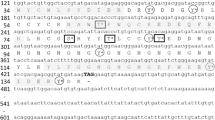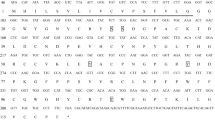Abstract
The granulin/epithelin precursor (GEP) encodes a glycoprotein precursor which exhibits pleiotropic tissue growth factor activity with multiple functions. Here, GEP was isolated and its role in the shell biomineralization process of the pearl oyster Pinctada fucata was investigated. Three forms of GEP mRNA were isolated from the pearl oyster (designated PfGEP-1, PfGEP-2 and PfGEP-3). Genomic DNA flanking the splicing region of the PfGEP variants was sequenced and it was found that PfGEP-2 splices out Exon 4, whereas PfGEP-3 splices out Exon 3 compared to PfGEP-1. PfGEP-1 (1505 amino acids) consists of 18 granulin domains, whereas PfGEP-2 (1459 amino acids) and PfGEP-3 (1471 amino acids) consist of 17.5 granulin domains, respectively. Analyses of PfGEP-1 and PfGEP-3 mRNA showed differential patterns in the tissues and developmental stages. Western blotting results showed that the three splice variants can translate to proteins in HEK293T cells. A knockdown experiment using PfGEP dsRNA showed decreased PfGEP-1/PfGEP-3 and PfMSX mRNA, and irregular crystallization of the nacreous layer using scanning electron microscopy. In luciferase assays, co-transfection of PfGEP-1 could activate as well as repress luciferase expression of the reporter plasmid driven by the PfMSX promoter, whereas PfGEP-3 stimulated the expression, elucidating the molecular mechanisms involved in the correlation between PfGEP and PfMSX. These results suggested that GEP variants might function differently during the biomineralization process, which provides new knowledge on the mechanism regulating nacre formation.





Similar content being viewed by others
References
Baba T, Hoff HB, Nemoto H, Lee H, Orth J, Arai Y, Gerton GL (1993) Acrogranin, an acrosomal cysteine-rich glycoprotein, is the precursor of the growth-modulating peptides, granulins, and epithelins, and is expressed in somatic as well as male germ cells. Mol Reprod Dev 34:233–243
Belcourt DR, Lazure C, Bennett H (1993) Isolation and primary structure of the three major forms of granulin-like peptides from hematopoietic tissues of a teleost fish (Cyprinus carpio). J Biol Chem 268:9230–9237
Bensoussan-Trigano V, Lallemand Y, Saint Cloment C, Robert B (2011) Msx1 and Msx2 in limb mesenchyme modulate digit number and identity. Dev Dynam 240:1190–1202
Bhandari V, Palfree R, Bateman A (1992) Isolation and sequence of the granulin precursor cDNA from human bone marrow reveals tandem cysteine-rich granulin domains. Proc Natl Acad Sci USA 89:1715–1719
Cao Z, Jiang B, Xie Y, Liu C, Feng JQ (2010) GEP, a local growth factor, is critical for odontogenesis and amelogenesis. Int J Biol Sci 6:719–729
Contreras-Moreira B, Bates PA (2002) Domain fishing: a first step in protein comparative modelling. Bioinformatics 18:1141–1142
Feng JQ, Guo FJ, Jiang BC, Zhang Y, Frenkel S, Wang DW, Tang W, Xie Y, Liu CJ (2010) Granulin epithelin precursor: a bone morphogenic protein 2-inducible growth factor that activates Erk1/2 signaling and JunB transcription factor in chondrogenesis. FASEB J 24:1879–1892
Gong N, Shangguan J, Liu X, Yan Z, Ma Z, Xie L, Zhang R (2008) Immunolocalization of matrix proteins in nacre lamellae and their in vivo effects on aragonitic tablet growth. J Struct Biol 164:33–40
Gordon J, Carriker M (1980) Sclerotized protein in the shell matrix of a bivalve mollusc. Mar Biol 57:251–260
Guex N, Peitsch MC (1997) SWISS-MODEL and the Swiss-Pdb viewer: an environment for comparative protein modeling. Electrophoresis 18:2714–2723
Hall TA (1999) BioEdit: a user-friendly biological sequence alignment editor and analysis program for Windows 95/98/NT. Nucl Acids Symp Ser 41:95–98
Hanington PC (2006) A Novel Hematopoietic Granulin Induces Proliferation of Goldfish (Carassius auratus L.) Macrophages. J Biol Chem 281:9963–9970
Hanington PC, Brennan LJ, Belosevic M, Andrew Keddie B (2008) Molecular and functional characterization of granulin-like molecules of insects. Insect Biochem Mol Biol 38:596–603
He Z, Bateman A (2003) Progranulin (granulin-epithelin precursor, PC-cell-derived growth factor, acrogranin) mediates tissue repair and tumorigenesis. J Mol Med 81:600–612
He Z, Ong CH, Halper J, Bateman A (2003) Progranulin is a mediator of the wound response. Nat Med 9:225–229
Hollnagel A, Oehlmann V, Heymer J, Rüther U, Nordheim A (1999) Id genes are direct targets of bone morphogenetic protein induction in embryonic stem cells. J Biol Chem 274:19838–19845
Hrabal R, Chen Z, James S, Bennett H, Ni F (1996) The hairpin stack fold, a novel protein architecture for a new family of protein growth factors. Nat Struct Biol 3:747–752
Huang X-D, Zhao M, Liu W-G, Guan Y-Y, Shi Y, Wang Q, Wu S-Z, He M-X (2012) Gigabase-Scale Transcriptome Analysis on Four Species of Pearl Oysters. Mar Biotechnol 15:253–264
Ishimura A, Maeda R, Takeda M, Kikkawa M, Daar IO, Maéno M (2000) Involvement of BMP-4/msx-1 and FGF pathways in neural induction in the Xenopus embryo. Dev Growth Differ 42:307–316
Jin Hong S, Won Kang K (1999) Purification of granulin-like polypeptide from the blood-sucking leech, Hirudo nipponia. Protein Expres Purif 16:340–346
Jüsten H-P, Grünewald E, Totzke G, Gouni-Berthold I, Sachinidis A, Wessinghage D, Vetter H, Schulze-Osthoff K, Ko Y (2000) Differential gene expression in synovium of rheumatoid arthritis and osteoarthritis. Mol Cell Biol Res Commun 3:165–172
Kumar S, Nei M, Dudley J, Tamura K (2008) MEGA: a biologist-centric software for evolutionary analysis of DNA and protein sequences. Brief Bioinform 9:299–306
Lallemand Y, Nicola M-A, Ramos C, Bach A, Saint Cloment C, Robert B (2005) Analysis of Msx1; Msx2 double mutants reveals multiple roles for Msx genes in limb development. Development 132:3003–3014
Liang J, Zhu L, Meng L, Chen D, Bian Z (2012) Novel nonsense mutation in MSX1 causes tooth agenesis with cleft lip in a Chinese family. Eur J Oral Sci 120:278–282
Liu J-P, Baker J, Perkins AS, Robertson EJ, Efstratiadis A (1993) Mice carrying null mutations of the genes encoding insulin-like growth factor I (Igf-1) and type 1 IGF receptor (Igf1r). Cell 75:59–72
Marcotte EM, Pellegrini M, Yeates TO, Eisenberg D (1999) A census of protein repeats. J Mol Biol 293:151–160
Miyashita T, Takagi R, Okushima M, Nakano S, Miyamoto H, Nishikawa E, Matsushiro A (2000) Complementary DNA cloning and characterization of pearlin, a new class of matrix protein in the nacreous layer of oyster pearls. Mar Biotechnol 2:409–418
Nam B-H, Park E-M, Kim Y-O, Kong HJ, Kim W-J, Kang J-H, Ji Y-J, Lee S-J, Choi T-J (2009) Identification of two differentially expressed forms of progranulin mRNA in the teleost fish Paralichthys olivaceus. Fish Shellfish Immunol 26:177–182
Nara K, Matsue H, Naraoka T (2004) Granulin-like peptide in the mid-gut gland of the bivalve mollusk, Patinopecten yessoensis. BBA-Gen Subjects 1675:147–154
Petersen TN, Brunak S, von Heijne G, Nielsen H (2011) SignalP 4.0: discriminating signal peptides from transmembrane regions. Nat Methods 8:785–786
Saadi I, Das P, Zhao M, Raj L, Ruspita I, Xia Y, Papaioannou VE, Bei M (2013) Msx1 and Tbx2 antagonistically regulate Bmp4 expression during the bud-to-cap stage transition in tooth development. Development 140:2697–2702
Samata T, Hayashi N, Kono M, Hasegawa K, Horita C, Akera S (1999) A new matrix protein family related to the nacreous layer formation of Pinctada fucata. FEBS Lett 462:225–229
Schultz J, Milpetz F, Bork P, Ponting CP (1998) SMART, a simple modular architecture research tool: identification of signaling domains. Proc Natl Acad Sci USA 95:5857–5864
Shen Z, Jacobs-Lorena M (1999) Evolution of chitin-binding proteins in invertebrates. J Mol Evol 48:341–347
Shen X, Belcher AM, Hansma PK, Stucky GD, Morse DE (1997) Molecular cloning and characterization of lustrin A, a matrix protein from shell and pearl nacre of Haliotis rufescens. J Biol Chem 272:32472–32481
Smout MJ, Laha T, Mulvenna J, Sripa B, Suttiprapa S, Jones A, Brindley PJ, Loukas A (2009) A granulin-like growth factor secreted by the carcinogenic liver fluke, Opisthorchis viverrini, promotes proliferation of host cells. PLoS Pathog 5:e1000611
Srivastava M, Begovic E, Chapman J, Putnam NH, Hellsten U, Kawashima T, Kuo A, Mitros T, Salamov A, Carpenter ML (2008) The Trichoplax genome and the nature of placozoans. Nature 454:955–960
Srivastava M, Simakov O, Chapman J, Fahey B, Gauthier ME, Mitros T, Richards GS, Conaco C, Dacre M, Hellsten U (2010) The Amphimedon queenslandica genome and the evolution of animal complexity. Nature 466:720–726
Sun X, Gulyas M, Hjerpe A (2004) Mesothelial differentiation as reflected by differential gene expression. Am J Resp Cell Mol 30:510–518
Suzuki M, Nishiahara M (2002) Granulin precursor gene: a sex steroid-inducible gene involved in sexual differentiation of the rat brain. Mol Genet Metab 75:31–37
Suzuki M, Saruwatari K, Kogure T, Yamamoto Y, Nishimura T, Kato T, Nagasawa H (2009) An acidic matrix protein, Pif, is a key macromolecule for nacre formation. Science 325:1388–1390
Tolkatchev D, Malik S, Vinogradova A, Wang P, Chen Z, Xu P, Bennett HP, Bateman A, Ni F (2008) Structure dissection of human progranulin identifies well-folded granulin/epithelin modules with unique functional activities. Protein Sci 17:711–724
Westbroek P, Marin F (1998) A marriage of bone and nacre. Nature 392:861–862
Zhao Y-P, Tian Q-Y, Frenkel S, Liu C-J (2013a) The promotion of bone healing by progranulin, a downstream molecule of BMP-2, through interacting with TNF/TNFR signaling. Biomaterials 34:6412–6421
Zhao J, Wei J, Liu M, Xiao L, Wu N, Liu G, Huang H, Zhang Y, Zheng L, Lin X (2013b) Cloning, characterization and expression of a cDNA encoding a granulin-like polypeptide in Ciona savignyi. Biochimie 95:1611–1619
Zhao M, He M, Huang X, Wang Q (2014) A Homeodomain Transcription Factor Gene, PfMSX, Activates Expression of Pif Gene in the Pearl Oyster Pinctada fucata. PLoS ONE 9:e103830
Zhu J, Nathan C, Jin W, Sim D, Ashcroft GS, Wahl SM, Lacomis L, Erdjument-Bromage H, Tempst P, Wright CD (2002) Conversion of proepithelin to epithelins: roles of SLPI and elastase in host defense and wound repair. Cell 111:867–878
Acknowledgments
This work was supported by the National Natural Science Foundation of China (41376159), the National Science and Technology Program of China (2012AA10A410).
Author information
Authors and Affiliations
Corresponding author
Ethics declarations
Conflict of interest
The authors declare that they have no conflict of interest.
Ethics statement
No specific permits were required for the field studies described, and the field studies did not involve endangered or protected species.
Additional information
Communicated by S. Hohmann.
Electronic supplementary material
Below is the link to the electronic supplementary material.
438_2015_1118_MOESM1_ESM.tif
Fig. S1. Full cDNA sequence and predicted amino acid sequence of PfGEP variants. (a) Full cDNA sequence and predicted amino acid sequence of PfGEP-1. The putative signal peptide is shown in bold. Granulin domains are shaded in gray. The asterisk marks the stop codon at the end of the open reading frame. The predicted O-glycosylation sites (amino acid residues 76, 109, 272, 410 and 701) are marked by an ellipse. Granulin domain 2 of PfGEP-1 is boxed in the black line and separated into two parts by a gray line. (b) cDNA sequence and predicted amino acid sequence of granulin domain 2 of PfGEP-2. The granulin domain 2 of PfGEP-2 is boxed and is the upper half of PfGEP-1′s granulin domain 2. (c) cDNA sequence and predicted amino acid sequence of granulin domain 2 of PfGEP-3: The cDNA sequence and predicted amino acid sequence which is boxed is the granulin domain 2 of PfGEP-3 and is the lower half of PfGEP-1′s granulin domain 2. Other than the granulin domain 2, PfGEP-1, -2 and -3 share the same sequence (TIFF 1307 kb)
438_2015_1118_MOESM3_ESM.tif
Fig. S3. Phylogenetic analysis of the PfGEP-1,-2 and -3 amino acid sequences with other known GEP sequences. The branches were validated by bootstrap analysis from 1000 replications, which were represented by percentage in branch nodes (TIFF 3753 kb)
Rights and permissions
About this article
Cite this article
Zhao, M., He, M., Huang, X. et al. Functional characterization and molecular mechanism exploration of three granulin epithelin precursor splice variants in biomineralization of the pearl oyster Pinctada fucata . Mol Genet Genomics 291, 399–409 (2016). https://doi.org/10.1007/s00438-015-1118-3
Received:
Accepted:
Published:
Issue Date:
DOI: https://doi.org/10.1007/s00438-015-1118-3




